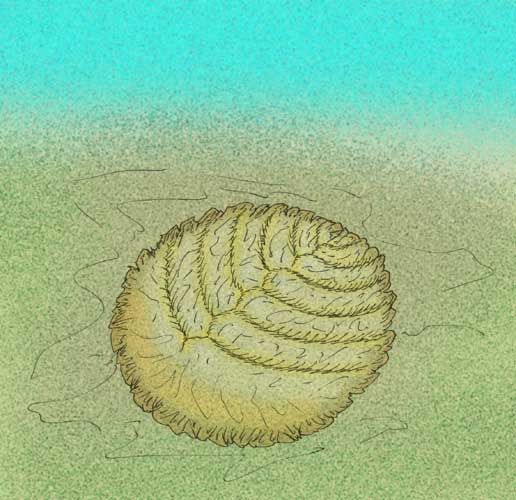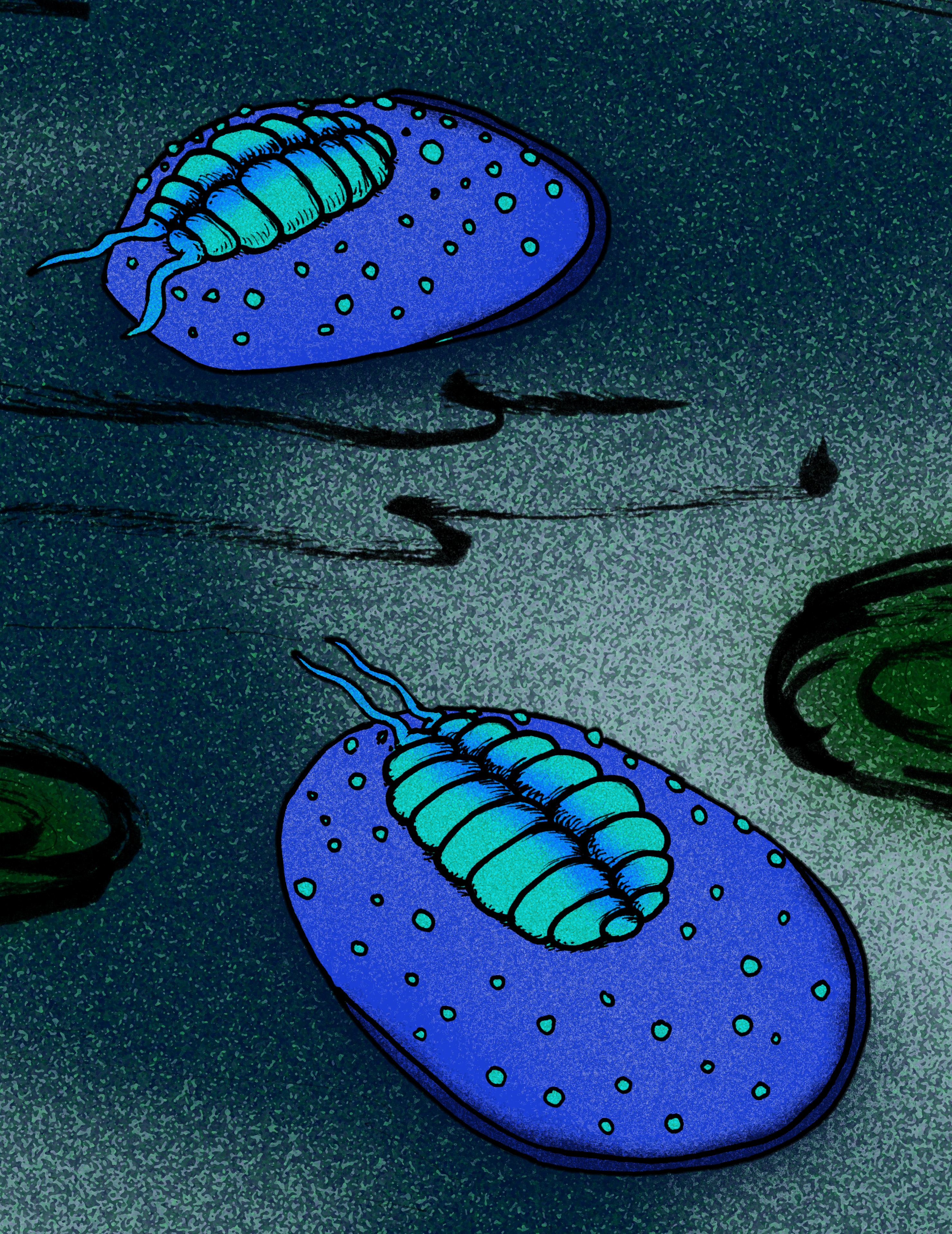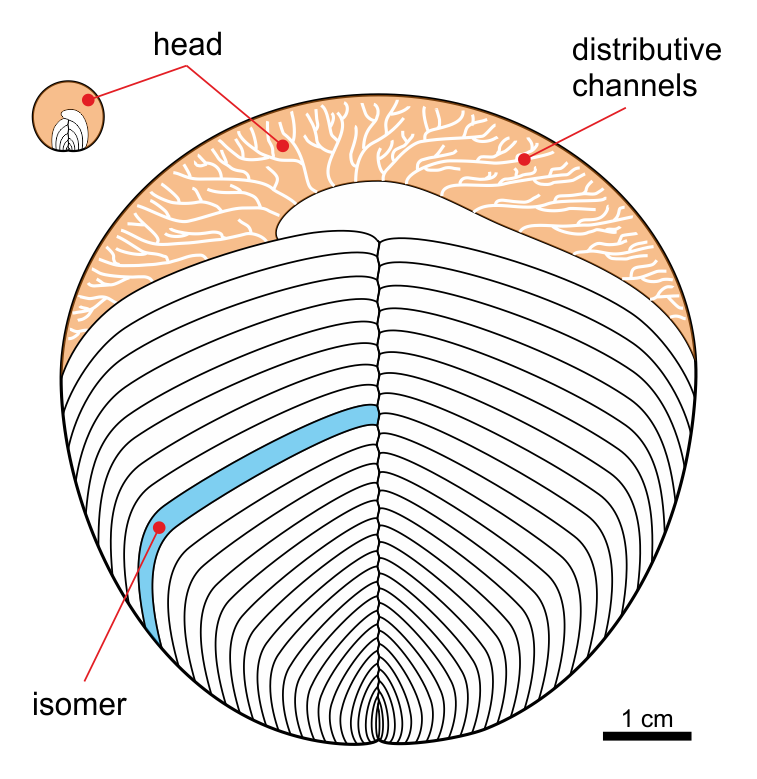|
Proarticulata
Proarticulata is a proposed phylum of extinct, near-bilaterally symmetrical animals known from fossils found in the Ediacaran (Vendian) marine deposits, and dates to approximately . The name comes from the Greek () = "before" and Articulata, i.e. prior to animals with true segmentation such as annelids and arthropods. This phylum was established by Mikhail A. Fedonkin in 1985 for such animals as ''Dickinsonia'', '' Vendia'', '' Cephalonega'', '' Praecambridium'' and currently many other Proarticulata are described (see list). Due to their simplistic morphology, their affinities and mode of life are subject to debate. They are almost universally considered to be metazoans, and due to possessing a clear central axis have been suggested to be stem-bilaterians. In the traditional interpretation, the Proarticulatan body is divided into transverse articulation (division) into isomers as distinct from the transverse articulation segments in annelids and arthropods, as their individu ... [...More Info...] [...Related Items...] OR: [Wikipedia] [Google] [Baidu] |
Isomer (Proarticulata)
Isomer (Greek ''isos'' = "equal", ''méros'' = "part") is an element of transverse body articulation of the bilateral fossil animals of the Phylum Proarticulata from the Ediacaran (Vendian) period. This term has been proposed by Andrey Yu. Ivantsov, a Russian paleontologist from the Laboratory of the Precambrian organisms, Paleontological Institute, Russian Academy of Sciences. Morphology Proarticulatan isomers are distinct from the segments of the Annelida and Panarthropoda, as each of these elements occupies only half of width of a body and are organized in an alternating pattern relatively to the axis of the body. In other words, although proarticulatans are bilaterally symmetrical, one side is not the direct mirror image of its opposite. Opposite isomers of left and right side are located with displacement of half of its width. This phenomenon is described as the symmetry of gliding reflection.M. A. Fedonkin (1985). "Systematic Description of Vendian Metazoa". In Sokolov, ... [...More Info...] [...Related Items...] OR: [Wikipedia] [Google] [Baidu] |
Dickinsonia
''Dickinsonia'' is a genus of extinct organism that lived during the late Ediacaran period in what is now Australia, China, Russia, and Ukraine. It had a round, bilaterally symmetric body with multiple segments running along it. It could range from a few millimeters to over a meter in length, and likely lived in shallow waters, feeding on the microbial mats that dominated the seascape at the time. As a member of the Ediacaran biota, its relationships to other organisms has been heavily debated. It was initially proposed to be a jellyfish, and over the years has been claimed to be a land-dwelling lichen, placozoan, or even a giant protist. Currently, the most popular interpretation is that it was a seafloor dwelling animal, perhaps a primitive stem group bilaterian, although this is still contentious. Among other Ediacaran organisms, it shares a close resemblance to other segmented forms like '' Vendia'', Yorgia and '' Spriggina'' and has been proposed to be a member of the ph ... [...More Info...] [...Related Items...] OR: [Wikipedia] [Google] [Baidu] |
Yorgia
''Yorgia waggoneri'' is a discoid Ediacaran organism. It has a low, segmented body consisting of a short wide "head", no appendages, and a long body region, reaching a maximum length of . It is classified within the extinct animal phylum Proarticulata. Etymology The generic name ''Yorgia'' comes from the Yorga river on the Zimnii Bereg (Winter Coast) of the White Sea, where the first specimens were found. The specific name ''Yorgia waggoneri'' honors the American paleontologist Ben Waggoner, who found the first specimen. Morphology The body plan of the ''Yorgia'' and other proarticulates is unusual for solitary (non-colonial) metazoans. These bilateral organisms have segmented metameric bodies, but left and right transverse elements (isomers) are organized in an alternating pattern relatively to the axis of the body – they are not direct mirror images. This phenomenon is described as the symmetry of glide reflection, which is a characteristic also found in the similar ''Spr ... [...More Info...] [...Related Items...] OR: [Wikipedia] [Google] [Baidu] |
Vendiamorpha
Vendiamorpha is a class of extinct animals within the Ediacaran phylum Proarticulata. The typical vendiamorph had an oval-shaped or round-shaped body divided completely into segmented isomers, that were arranged alternately in two rows with reference to the longitudinal axis of the body. Description The phenomenon of left-right alternating segments is called ''glide reflection symmetry'', and is a diagnostic feature of proarticulates. Transverse elements decrease in size from one end to the other and are inclined in the same direction. Typically, the first few, or largest initial isomers are fused together to form a headshield-like structure, leading some researchers to have originally considered them to be ancestral or related to arthropods, though, overwhelming evidence of them being proarticulates have since led researchers to discard this hypothetical relationship. Some vendiamorphs (e.g., ''Vendia'' and ''Paravendia'') supposedly demonstrate a digestive-distributive sy ... [...More Info...] [...Related Items...] OR: [Wikipedia] [Google] [Baidu] |
Cephalonega
''Cephalonega stepanovi'' is a fossil organism from Ediacaran deposits of the Arkhangelsk Region, Russia. It was described by Mikhail A. Fedonkin in 1976 Name Its original genus name ''Onega'' comes from the Onega Peninsula of the White Sea, where the first fossils were found. The species name was given to honour V.A. Stepanov, who discovered the Ediacaran fossil site on the Letniy Bereg (" Summer Coast") in 1972, on the Onega Peninsula, the first Proterozoic site found in the Arkhangelsk Oblast. The original generic name is previously occupied by the hemipteran genus ''Onega'' Distant (1908). Ivantsov ''et al.'' (2019) coined a replacement generic name ''Cephalonega''. Morphology The small fossils, which range up to long, have oval outlines and low bodies with an articulated central zone built of isomers encircled by an undivided zone. The surface of the undivided region of ''Cephalonega'' is covered with small tubercles. ''Cephalonega'' was originally described ... [...More Info...] [...Related Items...] OR: [Wikipedia] [Google] [Baidu] |
Cephalozoa
Cephalozoa are an extinct class (biology), class of primitive segmented marine organisms within the Phylum (biology), Phylum Proarticulata from the Ediacaran period. They possessed bilateral symmetry and were characterized by a thin, rounded body. Description Unlike the other classes of proarticulata, proarticulates, the segmentation of the body is not complete and shows a "head" with fine distribution channels. Some species of the Yorgiidae family also show some asymmetry. They were discovered in Russia near the White Sea in the Arkhangelsk region, where they lived during the Ediacaran, approximately 635 to 540 myr, Ma (millions of years ago). Taxonomy Cephalozoa includes the families Yorgiidae and Sprigginidae: Yorgiidae *† ''Archaeaspinus'' Ivantsov, 2007 (synonym of ''Archaeaspis'') **† ''Archaeaspinus fedonkini'' Ivantsov, 2001 *† ''Yorgia'' Ivantsov, 1999 **† ''Yorgia waggoneri'' Ivantsov, 1999 Sprigginidae *† ''Spriggina'' Glaessner, 1958 **† ''Spriggina fl ... [...More Info...] [...Related Items...] OR: [Wikipedia] [Google] [Baidu] |
Sprigginidae
Sprigginidae is an extinct family of the class Cephalozoa, characterized by having a greater number of isomers than its sister taxon, Yorgiidae. They lived approximately 635 million years ago, in the Ediacaran period. Description Like most members of Proarticulata, their body plan consists of isomers arranged in a glide symmetry, meaning they do not have true bilateral symmetry, although what sets them out from other proarticulates is their greater number of isomers, numbering up to around 40, sometimes more, overall. They also have a distinct 'horseshoe' shaped 'head'. When the first member of the family, ''Spriggina'', was discovered, it was considered to be a polychaete annelid, and petalonamid frond, and even an arthropod, with probable relations to trilobites. Although most recent studies now agree that ''Spriggina'', and the family its apart of, are apart of the phylum Proarticulata. Distribution Most genera are restricted to sediments within the Flinders Ranges of Sou ... [...More Info...] [...Related Items...] OR: [Wikipedia] [Google] [Baidu] |
Karakhtia
''Karakhtia nessovi'' is a species of Proarticulate from the Ediacaran period, around 555 Million Years Ago. K. nessovi is the only species in the genus ''Karakhtia''. The genus '' Haootia'' has been compared minorly to ''Karakhtia'' in the way that the fossils of ''Haootia'' superficially resemble the crumpled margins of ''Karakhtia''. Discovery and name The holotype fossil of ''Karakhtia'' was found from the Ustʹ Pinega Formation, in the White Sea of Russia, and described in 2004. The generic name ''Karakhtia'' is derived from the place name ''Karakhta River'', near to where the fossil material was found. The specific name ''nessovi'' is derived from the surname of ''L.A. Nessov'', a Leningrad paleontologist. Description ''Karakhtia nessovi'' is a Proarticulate from the Vendiidae family, growing up to in length, and like other members of its family, it has a headshield-like structure. Unlike anything seen in other Proarticulates, it features a margin with radial fol ... [...More Info...] [...Related Items...] OR: [Wikipedia] [Google] [Baidu] |
Yorgiidae
Yorgiidae is an extinct family of the class Cephalozoa, which is a part of the wider phylum Proarticulata. They lived from around 571 to 551 Ma. Description Like other relatives within the phylum Proarticulata, their body plan consists of isomers arranged in a glide symmetry, meaning they do not have true bilateral symmetry. As with other cephalozoans, their initial right isomer extends right across the body, forming a distinctive 'head', whilst they have a unique feature with their initial left isomer extending slightly to the right side and into the initial right isomer. This is most prominent in the genus ''Archaeaspinus'', with it having an unpaired left lobe/isomer within its 'head' region, forming a distinctive question mark-like shape. Distribution Genera of the family Yorgiidae are most commonly found in the Ust' Pinega Formation and Central Urals of Russia, as well as the Flinders Ranges of South Australia. Taxonomy Yorgiidae includes the following genera: *� ... [...More Info...] [...Related Items...] OR: [Wikipedia] [Google] [Baidu] |


